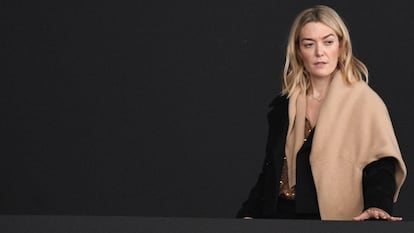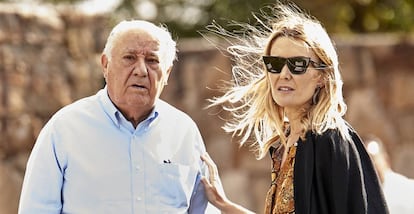Why now? The key points behind the changes at Inditex, including the appointment of Marta Ortega as chair
The company brought forward the naming of the group founder’s daughter in this key role thanks to its strong position in the wake of the Covid crisis

Inditex, the largest company in Spain’s blue-chip Ibex 35, with a market value of €87 billion, announced sweeping changes to its leadership team on Tuesday. Starting April 1, Marta Ortega – the daughter of Inditex’s founder Amancio Ortega – will be the new chair of the company, which owns fashion brands such as Zara, Massimo Dutti and Bershka. The 37-year-old will be taking over from Pablo Isla, who has been in the position for more than a decade and has played a key role in making Inditex one of the leading fashion companies in the world. Isla has also overseen the business’s digital transformation, a move that has helped keep the company afloat during the coronavirus pandemic. The decision to appoint Marta Ortega as chairperson follows Isla’s request to step down from the position, something that was approved by Amancio Ortega.
But why has this move happened now? And what will it mean for the company? Here are the key points behind the changes that have captured the attention of the business world.
New leadership
The biggest change announced on Tuesday is the appointment of Marta Ortega as the chair of Inditex, a position she will assume on April 1. The 37-year-old will become a non-executive chairperson, meaning that while she will be the head of the company and supervise all its operations, she will not be as involved with the daily management of its financial performance. This formula is aimed at shielding Marta Ortega from too much public exposure.
This side of the business will be run by Óscar García Maceiras, who is currently Inditex’s general secretary and secretary of the board. He will be appointed CEO, a position that he had been considered for since he joined Inditex in March. In this way, Inditex will return to the dual leadership it was under for six years, when Pablo Isla was CEO and Amancio Ortega was chairman.
“These changes are very significant for the company and well thought out. They are part of a process within the company,” said Isla at a press conference following the announcement on Tuesday, in which he was accompanied by García Maceiras. “Now is the moment to face the next stage.”
Isla explained that while this way of sharing executive powers – with Marta Ortega as chair and García Maceiras as CEO – was not yet common in Spain’s corporate world, it is often used by large companies in several European countries, as well as outside of the European Union.
Why now?
According to Isla, these changes are the culmination of “a generational handover process that began in 2011 with the replacement of Amancio Ortega as the chairman of Inditex.” Indeed, this move had been predicted, although it came earlier than expected. “We have been preparing this transition for some time, discreetly,” said Isla on various occasions, in response to questions from the press.

The question is: why now? One of the main reasons the handover has been pushed forward is the fact that Inditex is now in a strong position, having appeared to have overcome the impact of the coronavirus crisis. “We believe it is an optimal moment,” said Isla on Tuesday. “The company is very solid; it has a well-defined strategy and a fantastic team.” Inditex ended 2020, the most difficult year in its history due to the pandemic, with €1.1 billion in profit, 70% less than the previous year. And in 2021, it exceeded pre-pandemic levels in the first quarter of the year: between February and July, it recorded €11.9 billion in revenue, far more than sales from the same period in 2020, and even better than figures from 2019.
Another factor that has influenced the decision is the fact that 85-year-old Amancio Ortega, who founded the fashion giant in 1975, is still an active presence in the company – a point that also helps facilitate the transition of leadership. Indeed, the decision to bring forward the handover came from both Isla and Amancio Ortega, indicating its strategic importance to Inditex.
Will this mean a change in direction?
Despite the scale of these leadership changes, they do not indicate a change in direction, said Isla. “Evidently, the company model will continue as it has been up to now.”
Challenges faced by Marta Ortega
Consolidating the digital transformation of the company is one of the main challenges faced by the daughter of the Inditex founder. This is one of the biggest areas that helped the business continue to grow despite the fallout of the coronavirus crisis. Inditex invested millions of euros in creating a complex digital system based on its very own platform. This system allows, among other things, for the company to bring together the inventories of its physical and online stores, as well as prepare online purchases directly from its physical stores. This has been a key to helping the company increase sales even though physical shops were closed to the public or at restricted capacity due to the pandemic.
For Marta Ortega, taking on the position as chair is also a personal challenge. “I have always said I would dedicate my life to building upon my parents’ legacy, looking to the future but learning from the past and serving the company, our shareholders and our customers,” she said in a press release sent by Inditex on Tuesday.
“I feel profoundly honored and committed for the trust that has been placed in me, and enormously excited for the future that we are going to take on together,” said Marta Ortega, who is the youngest of Amancio Ortega’s three children.
The 37-year-old has been working in different departments of Inditex since she was 15, in particularly in brand building and fashion proposals for Zara, an area she will continue supervising.
Another important challenge will be defining the future of Inditex’s bricks-and-mortar stores. For years, the company has opted to close these units in order to focus on the largest retailers, particularly those in the best locations. This strategy is likely to be maintained, based on remarks from García Maceiras. “The business model is very solid and stable. The company has shown that it knows how to adapt to new circumstances and our job is to continue and develop it,” he said on Tuesday.
Future of Pablo Isla
During the press conference on Tuesday, Isla was asked many times about what he was going to do after Inditex. But the current chairman made it clear that now was not the time to think about his future career. “In these four months, I am going to be fully focused on culminating this transition, which is vital and very important for me. Afterward, we’ll see what happens,” he said.
Isla, who began his career as a state lawyer, has twice been named the best-performing CEO in the world by the journal Harvard Business Review. Under his leadership, Inditex has become a world leader in the fashion sector, outstripping Sweden’s H&M, Japan’s Fast Retailing (which owns Uniqlo) and the US company GAP.
Tu suscripción se está usando en otro dispositivo
¿Quieres añadir otro usuario a tu suscripción?
Si continúas leyendo en este dispositivo, no se podrá leer en el otro.
FlechaTu suscripción se está usando en otro dispositivo y solo puedes acceder a EL PAÍS desde un dispositivo a la vez.
Si quieres compartir tu cuenta, cambia tu suscripción a la modalidad Premium, así podrás añadir otro usuario. Cada uno accederá con su propia cuenta de email, lo que os permitirá personalizar vuestra experiencia en EL PAÍS.
¿Tienes una suscripción de empresa? Accede aquí para contratar más cuentas.
En el caso de no saber quién está usando tu cuenta, te recomendamos cambiar tu contraseña aquí.
Si decides continuar compartiendo tu cuenta, este mensaje se mostrará en tu dispositivo y en el de la otra persona que está usando tu cuenta de forma indefinida, afectando a tu experiencia de lectura. Puedes consultar aquí los términos y condiciones de la suscripción digital.
More information
Últimas noticias
Most viewed
- Oona Chaplin: ‘I told James Cameron that I was living in a treehouse and starting a permaculture project with a friend’
- Sinaloa Cartel war is taking its toll on Los Chapitos
- Reinhard Genzel, Nobel laureate in physics: ‘One-minute videos will never give you the truth’
- Why the price of coffee has skyrocketed: from Brazilian plantations to specialty coffee houses
- Silver prices are going crazy: This is what’s fueling the rally











































